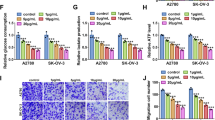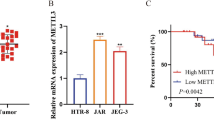Abstract
Choriocarcinoma is an aggressive gestational trophoblastic neoplasm. This study attempted to explore the biological functions and underlying mechanisms by which ropivacaine restrains the progression of choriocarcinoma. The expression of long noncoding RNA OGFRP1, microRNA-4731-5p (miR-4731-5p), and HIF3A in choriocarcinoma cells was assessed by qRT-PCR. Choriocarcinoma cells treated with ropivacaine at the concentration of 100, 500, and 1000 μM were cultured for 24, 48, and 72 h, respectively. Choriocarcinoma cell viability was evaluated by MTT assay. Transwell assay was conducted to examine choriocarcinoma cell migration and invasion. Additionally, the target relationship between OGFRP1 and miR-4731-5p or between miR-4731-5p and HIF3A was predicted by bioinformatics analysis and confirmed by dual-luciferase reporter assays. OGFRP1 and HIF3A expression were enhanced in choriocarcinoma cells, while miR-4731-5p expression was inhibited. Treatment with ropivacaine impeded choriocarcinoma cell viability, migration, and invasion. Choriocarcinoma cells treated with 1000 μM ropivacaine for 48 h were selected for subsequent experiments. OGFRP1 elevation or miR-4731-5p deficiency mitigated the reduction effect of ropivacaine on tumorigenesis of choriocarcinoma cells. Besides, miR-4731-5p was predicted as the potential OGFRP1 target by StarBase and LncBase, and HIF3A was predicted as the potential miR-4731-5p target by StarBase and TargetScan. Dual-luciferase reporter assays determined that miR-4731-5p was a target of OGFRP1 and HIF3A was a target of miR-4731-5p. Feedback experiments declared that miR-4731-5p elevation or HIF3A suppression reversed the promoting effect of OGFRP1 overexpression on the malignant behaviors of ropivacaine-treated choriocarcinoma cells. Ropivacaine constrained choriocarcinoma cell viability, migration, and invasion through modulating the OGFRP1/miR-4731-5p/HIF3A axis. Our study may provide a novel strategy for choriocarcinoma prevention and treatment.






Similar content being viewed by others
Data Availability
All data in the manuscript are available through the responsible corresponding author.
References
Savage, J., Adams, E., Veras, E., Murphy, K. M., & Ronnett, B. M. (2017). Choriocarcinoma in women: Analysis of a case series with genotyping. American Journal of Surgical Pathology, 41(12), 1593–1606.
Zhang, X., Yan, K., Chen, J., & Xie, X. (2019). Using short tandem repeat analysis for choriocarcinoma diagnosis: A case series. Diagnostic Pathology, 14(1), 019–0866.
Park, W., Park, S., Lim, W., & Song, G. (2018). Chrysin disrupts intracellular homeostasis through mitochondria-mediated cell death in human choriocarcinoma cells. Biochemical and Biophysical Research Communications, 503(4), 3155–3161.
Lim, W., Yang, C., Jeong, M., Bazer, F. W., & Song, G. (2017). Coumestrol induces mitochondrial dysfunction by stimulating ROS production and calcium ion influx into mitochondria in human placental choriocarcinoma cells. Molecular Human Reproduction, 23(11), 786–802.
Chen, C., & You, P. (2017). A novel local anesthetic system: Transcriptional transactivator peptide-decorated nanocarriers for skin delivery of ropivacaine. Drug Design, Development and Therapy, 11, 1941–1949.
Zhang, Y., Peng, X., & Zheng, Q. (2018). Ropivacaine inhibits the migration of esophageal cancer cells via sodium-channel-independent but prenylation-dependent inhibition of Rac1/JNK/paxillin/FAK. Biochemical and Biophysical Research Communications, 501(4), 1074–1079.
Yang, W., Cai, J., Zhang, H., Wang, G., & Jiang, W. (2018). Effects of lidocaine and ropivacaine on gastric cancer cells through down-regulation of ERK1/2 phosphorylation in vitro. Anticancer Research, 38(12), 6729–6735.
Gong, X., Dan, J., Li, F., & Wang, L. (2018). Suppression of mitochondrial respiration with local anesthetic ropivacaine targets breast cancer cells. Journal of Thoracic Disease, 10(5), 2804–2812.
Siekmann, W., Tina, E., Von Sydow, A. K., & Gupta, A. (2019). Effect of lidocaine and ropivacaine on primary (SW480) and metastatic (SW620) colon cancer cell lines. Oncology Letters, 18(1), 395–401.
Chen, X., Liu, W., Guo, X., Huang, S., & Song, X. (2020). Ropivacaine inhibits cervical cancer cell growth via suppression of the miR-96/MEG2/pSTAT3 axis. Oncology Reports, 43(5), 1659–1668.
Liu, Y., Yang, Y., Li, L., Geng, P., Li, G., & Song, H. (2018). LncRNA SNHG1 enhances cell proliferation, migration, and invasion in cervical cancer. Biochemistry and Cell Biology, 96(1), 38–43.
Du, W., Feng, Z., & Sun, Q. (2018). LncRNA LINC00319 accelerates ovarian cancer progression through miR-423-5p/NACC1 pathway. Biochemical and Biophysical Research Communications, 507(1–4), 198–202.
Yu, S., Wu, C., Tan, Q., & Liu, H. (2019). Long noncoding RNA H19 promotes chemotherapy resistance in choriocarcinoma cells. Journal of Cellular Biochemistry, 120(9), 15131–15144.
Yan, K., Hou, L., Liu, T., Jiao, W., Ma, Q., Fang, Z., Zhang, S., Song, D., Liu, J., Gao, X., & Fan, Y. (2020). lncRNA OGFRP1 functions as a ceRNA to promote the progression of prostate cancer by regulating SARM1 level via miR-124-3p. Aging, 12(10), 8880–8892.
Chen, W., You, J., Zheng, Q., & Zhu, Y. Y. (2018). Downregulation of lncRNA OGFRP1 inhibits hepatocellular carcinoma progression by AKT/mTOR and Wnt/β-catenin signaling pathways. Cancer Management and Research, 10, 1817–1826.
Meng, Q., & Xue, H. (2020). Knockdown of lncRNA OGFRP1 Inhibits Proliferation and Invasion of JEG-3 Cells Via AKT/mTOR Pathway. Technology in Cancer Research & Treatment, 19(1533033820905823), 1533033820905823.
Guo, Z., Sui, L., Qi, J., Sun, Q., Xu, Y., Zou, N., Xie, Y., & Kong, Y. (2019). miR-196b inhibits cell migration and invasion through targeting MAP3K1 in hydatidiform mole. Biomedicine & Pharmacotherapy, 113(108760), 16.
Pang, R. T., Leung, C. O., Lee, C. L., Lam, K. K., Ye, T. M., Chiu, P. C., & Yeung, W. S. (2013). MicroRNA-34a is a tumor suppressor in choriocarcinoma via regulation of Delta-like1. BMC Cancer, 13(25), 1471–2407.
Allahverdi, A., Arefian, E., Soleimani, M., Ai, J., Nahanmoghaddam, N., Yousefi-Ahmadipour, A., & Ebrahimi-Barough, S. (2020). MicroRNA-4731-5p delivered by AD-mesenchymal stem cells induces cell cycle arrest and apoptosis in glioblastoma. Journal of Cellular Physiology, 235(11), 8167–8175.
Stark, M. S., Tom, L. N., Boyle, G. M., Bonazzi, V. F., Soyer, H. P., Herington, A. C., Pollock, P. M., & Hayward, N. K. (2016). The “melanoma-enriched” microRNA miR-4731-5p acts as a tumour suppressor. Oncotarget, 7(31), 49677–49687.
Yan, Z., Zhang, W., Xiong, Y., Wang, Y., & Li, Z. (2020). Long noncoding RNA FLVCR1-AS1 aggravates biological behaviors of glioma cells via targeting miR-4731-5p/E2F2 axis. Biochemical and Biophysical Research Communications, 521(3), 716–720.
Yang, S. L., Wu, C., Xiong, Z. F., & Fang, X. (2015). Progress on hypoxia-inducible factor-3: Its structure, gene regulation and biological function (Review). Molecular Medicine Reports, 12(2), 2411–2416.
Sun, D. G., Tian, S., Zhang, L., Hu, Y., Guan, C. Y., Ma, X., & Xia, H. F. (2020). The miRNA-29b is downregulated in placenta during gestational diabetes mellitus and may alter placenta development by regulating trophoblast migration and invasion through a HIF3A-dependent mechanism. Front Endocrinol. https://doi.org/10.3389/fendo.2020.00169
Shen, J., Song, R., Ye, Y., Wu, X., Chow, W. H., & Zhao, H. (2020). HIF3A DNA methylation, obesity and weight gain, and breast cancer risk among Mexican American women. Obesity Research & Clinical Practice, 14(6), 548–553.
Xue, X., Jungles, K., Onder, G., Samhoun, J., Győrffy, B., & Hardiman, K. M. (2016). HIF-3α1 promotes colorectal tumor cell growth by activation of JAK-STAT3 signaling. Oncotarget, 7(10), 11567–11579.
Zhang, C., Liu, J., Zhang, Y., Luo, C., Zhu, T., Zhang, R., & Yao, R. (2020). LINC01342 promotes the progression of ovarian cancer by absorbing microRNA-30c-2-3p to upregulate HIF3A. Journal of Cellular Physiology, 235(4), 3939–3949.
Zhang, Y., Guo, Y., Yang, C., Zhang, S., Zhu, X., Cao, L., Nie, W., & Yu, H. (2017). MicroRNA-300 targets hypoxia inducible factor-3 alpha to inhibit tumorigenesis of human non-small cell lung cancer. Neoplasma, 64(4), 554–562.
Ji, L., & Li, X. (2019). Long noncoding RNA MEG3 is a tumor suppressor in choriocarcinoma by upregulation of microRNA-211. Journal of Cellular Physiology, 234(12), 22911–22920.
Li, R., Xiao, C., Liu, H., Huang, Y., Dilger, J. P., & Lin, J. (2018). Effects of local anesthetics on breast cancer cell viability and migration. BMC Cancer, 18(1), 018–4576.
Zhang, N., Xing, X., Gu, F., Zhou, G., Liu, X., & Li, B. (2020). Ropivacaine inhibits the growth, migration and invasion of gastric cancer through attenuation of WEE1 and PI3K/AKT signaling via miR-520a-3p. Oncotargets and Therapy, 13, 5309–5321.
Wang, X., & Li, T. (2021). Ropivacaine inhibits the proliferation and migration of colorectal cancer cells through ITGB1. Bioengineered, 12(1), 44–53.
Shi, D., Zhang, Y., & Lu, R. (2018). The long non-coding RNA MALAT1 interacted with miR-218 modulates choriocarcinoma growth by targeting Fbxw8. Biomedicine & Pharmacotherapy, 97, 543–550.
Wang, Y. N., Liu, S. Y., Wang, L., & Han, L. Y. (2019). Long noncoding RNA PCA3 contributes to the progression of choriocarcinoma by acting as a ceRNA against miR-106b. International Journal of Clinical and Experimental Pathology, 12(5), 1609–1617.
Zou, K., Yu, H., Chen, X., Ma, Q., & Hou, L. (2019). Silencing long noncoding RNA OGFRP1 inhibits the proliferation and migration of cervical carcinoma cells. Cell Biochemistry and Function, 37(8), 591–597.
Zhang, L., Wan, Q., & Zhou, H. (2020). Targeted-regulating of miR-515–5p by LncRNA LOXL1-AS1 on the proliferation and migration of trophoblast cells. Experimental and Molecular Pathology, 118, 104588.
Gholizadeh, N., Emami Razavi, A., Mohammadpour, H., Tavakol, F., & Sheykhbahaei, N. (2020). Association of MAPK and its regulatory miRNAs (603, 4301, 8485, and 4731) with the malignant transformation of oral lichen planus. Molecular Biology Reports, 47(2), 1223–1232.
Bjerre, M. T., Strand, S. H., Nørgaard, M., Kristensen, H., Rasmussen, A. K., Mortensen, M. M., Fredsøe, J., Mouritzen, P., Ulhøi, B., Ørntoft, T., Borre, M., & Sørensen, K. D. (2019). Aberrant DOCK2, GRASP, HIF3A and PKFP hypermethylation has potential as a prognostic biomarker for prostate cancer. International Journal of Molecular Science, 20(5), 1173.
Zhou, X., Guo, X., Chen, M., Xie, C., & Jiang, J. (2018). HIF-3α promotes metastatic phenotypes in pancreatic cancer by transcriptional regulation of the RhoC-ROCK1 signaling pathway. Molecular Cancer Research, 16(1), 124–134.
Silakit, R., Kitirat, Y., Thongchot, S., Loilome, W., Techasen, A., Ungarreevittaya, P., Khuntikeo, N., Yongvanit, P., Yang, J. H., Kim, N. H., Yook, J. I., & Namwat, N. (2018). Potential role of HIF-1-responsive microRNA210/HIF3 axis on gemcitabine resistance in cholangiocarcinoma cells. PLoS ONE, 13(6), e0199827. https://doi.org/10.1371/journal.pone.0199827
Funding
None.
Author information
Authors and Affiliations
Contributions
YJL contributed significantly to conception, design, and analysis of data, performed the experiments and the data analyses, and wrote the manuscript. CY and LZ contributed significantly to analysis and manuscript preparation, performed the experiments and the data analyses, and revised the manuscript. JD contributed significantly to manuscript preparation, performed the experiments, and revised the manuscript. All authors have read and approved the manuscript.
Corresponding author
Ethics declarations
Conflict of interest
The authors declare that they have no conflicts of interest to disclose.
Consent to Participate
Not applicable.
Consent for Publication
Not applicable.
Additional information
Publisher's Note
Springer Nature remains neutral with regard to jurisdictional claims in published maps and institutional affiliations.
Rights and permissions
About this article
Cite this article
Lu, Y., Yang, C., Zhang, L. et al. Ropivacaine Retards the Viability, Migration, and Invasion of Choriocarcinoma Cells by Regulating the Long Noncoding RNA OGFRP1/MicroRNA-4731-5p/HIF3A Axis. Mol Biotechnol 64, 499–509 (2022). https://doi.org/10.1007/s12033-021-00429-1
Received:
Accepted:
Published:
Issue Date:
DOI: https://doi.org/10.1007/s12033-021-00429-1




